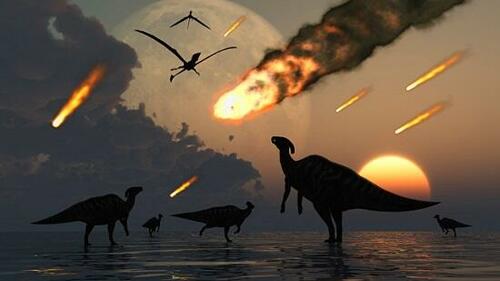
Authored by Charles Hugh Smith via OfTwoMinds blog,
The economy has reached an inflection point where everything that is unsustainable finally starts unraveling.
Our economy is in a crisis that's been brewing for decades. The Chinese characters for the English word crisis are famously--and incorrectly--translated as danger and opportunity. The more accurate translation is precarious plus critical juncture or inflection point.
Beneath its surface stability, our economy is precarious because the foundation of the global economy-- cheap energy--has reached an inflection point: from now on, energy will become more expensive.
The cost will be too low for energy producers to make enough money to invest in future energy production, and too high for consumers to have enough money left after paying for the essentials of energy, food, shelter, etc., to spend freely.
For the hundred years that resources were cheap and abundant, we could waste everything and call it growth: when an appliance went to the landfill because it was designed to fail (planned obsolescence) so a new one would have to be purchased, that waste was called growth because the Gross Domestic Product (GDP) went up when the replacement was purchased.
A million vehicles idling in a traffic jam was also called growth because more gasoline was consumed, even though the gasoline was wasted.
This is why the global economy is a "waste is growth" Landfill Economy. The faster something ends up in the landfill, the higher the growth.
Now that we've consumed all the easy-to-get resources, all that's left is hard to get and expensive. For example, minerals buried in mountains hundreds of miles from paved roads and harbors require enormous investments in infrastructure just to reach the deposits, extract, process and ship them to distant mills and refineries. Oil deposits that are deep beneath the ocean floor are not cheap to get.
Does it really make sense to expect that the human population can triple and our consumption of energy increase ten-fold and there will always be enough resources to keep supplies abundant and prices low? No, it doesn't.
Many people believe that nuclear power (fusion, thorium reactors, mini-reactors, etc.) will provide cheap, safe electricity that will replace hydrocarbons (oil and natural gas). But nuclear power is inherently costly, and there are presently no full-scale fusion or thorium reactors providing cheap electricity to thousands of households.
Reactors take many years to construct and are costly to build and maintain. Cost over-runs are common. A new reactor in Finland, for example, is nine years behind schedule and costs have tripled.
The U.S. has built only two new reactors in the past 25 years.
The world's 440 reactors supply about 10% of global electricity. There are currently 55 new reactors under construction in 19 countries, but it will take many years before they produce electricity. We would have to build a new reactor a week for many years to replace hydrocarbon-generated electricity. This scale of construction simply isn't practical.
Supplying all energy consumption globally--for all transportation, heating of buildings, etc.) would require over 10,000 reactors by some estimates--over 20 times the current number of reactors in service.
Many believe so-called renewable energy such as solar and wind will replace hydrocarbons. But as analysts Nate Hagens has explained, these sources are not truly renewable, they are replaceable; all solar panels and wind turbines must be replaced at great expense every 20 to 25 years. These sources are less than 5% of all energy we consume, and it will take many decades of expansion to replace even half of the hydrocarbon fuels we currently consume.
To double the energy generated by wind/solar in 25 years, we’ll need to build three for each one in service today: one to replace the existing one and two more to double the energy being produced.
All these replacements for hydrocarbons require vast amounts of resources: diesel fuel for transport, materials for fabricating turbines, panels, concrete foundations, and so on.
Humans are wired to want to believe that whatever we have now will still be ours in the future. We don't like being told we'll have less of anything in the future.
The current solution is to create more money out of thin air in the belief that if we create more money, then more oil, copper, iron, etc. will be found and extracted.
But this isn't really a solution. What happens if we add a zero to all our currency? If we add a zero to a $10 bill so it becomes $100, do we suddenly get ten times more food, gasoline, etc. with the new bill? No.
Prices quickly rise ten-fold so the new $100 bill buys the same amount as the old $10.
Adding zeroes to our money (hyper-financialization) doesn’t make everything that's scarce, expensive and hard to get suddenly cheap. It's still scarce, expensive and hard to get no matter how many zeroes we add to our money.
Many people feel good about recycling a small part of what we consume. But recycling is not cost-free, and the majority of what we consume is not recycled.
The percentage of lithium batteries that are recycled, for example, is very low, less than 5%. We have to mine vast quantities of lithium because we dump 95% of lithium-ion batteries in the landfill. There are many reasons for this, one being that the batteries aren't designed to be recycled because this would cost more money.
The majority of all manufactured goods--goods that required immense amounts of hydrocarbons to make--are tossed in the landfill.
Goods and services are commoditized and sourced from all over the world in long dependency chains (hyper-globalization): if one link breaks, the entire supply chain breaks.
Our economy is precarious because it's in a lose-lose dilemma: resource prices can't stay high enough for producers to make a profit without impoverishing consumers. Prices can't stay low enough to allow consumers to spend freely without producers losing money and shutting down, depriving the economy of essential resources.
Playing hyper-financialized games--creating money out of thin air, borrowing from tomorrow to spend more today and inflating speculative bubbles in stocks, housing, etc.--won't actually create more of what's scarce. All these games make wealth inequality worse (hyper-inequality), undermining social stability.
The economy has reached an inflection point where everything that is unsustainable finally starts unraveling. Each of these systems is dependent on all the other systems (what we call a tightly bound system), so when one critical system unravels, the crisis quickly spreads to the entire economic system: one domino falling knocks down all the dominoes snaking through the global economy.
Those who understand how tightly interconnected, unsustainable systems are basically designed to unravel can prepare themselves by becoming antifragile: flexible, adaptable and open to the opportunities that arise when things are disorderly and unpredictable.
* * *
My new book is now available at a 10% discount this month: When You Can't Go On: Burnout, Reckoning and Renewal. If you found value in this content, please join me in seeking solutions by becoming a $1/month patron of my work via patreon.com.
Authored by Charles Hugh Smith via OfTwoMinds blog,
The economy has reached an inflection point where everything that is unsustainable finally starts unraveling.
Our economy is in a crisis that’s been brewing for decades. The Chinese characters for the English word crisis are famously–and incorrectly–translated as danger and opportunity. The more accurate translation is precarious plus critical juncture or inflection point.
Beneath its surface stability, our economy is precarious because the foundation of the global economy– cheap energy–has reached an inflection point: from now on, energy will become more expensive.
The cost will be too low for energy producers to make enough money to invest in future energy production, and too high for consumers to have enough money left after paying for the essentials of energy, food, shelter, etc., to spend freely.
For the hundred years that resources were cheap and abundant, we could waste everything and call it growth: when an appliance went to the landfill because it was designed to fail (planned obsolescence) so a new one would have to be purchased, that waste was called growth because the Gross Domestic Product (GDP) went up when the replacement was purchased.
A million vehicles idling in a traffic jam was also called growth because more gasoline was consumed, even though the gasoline was wasted.
This is why the global economy is a “waste is growth” Landfill Economy. The faster something ends up in the landfill, the higher the growth.
Now that we’ve consumed all the easy-to-get resources, all that’s left is hard to get and expensive. For example, minerals buried in mountains hundreds of miles from paved roads and harbors require enormous investments in infrastructure just to reach the deposits, extract, process and ship them to distant mills and refineries. Oil deposits that are deep beneath the ocean floor are not cheap to get.
Does it really make sense to expect that the human population can triple and our consumption of energy increase ten-fold and there will always be enough resources to keep supplies abundant and prices low? No, it doesn’t.
Many people believe that nuclear power (fusion, thorium reactors, mini-reactors, etc.) will provide cheap, safe electricity that will replace hydrocarbons (oil and natural gas). But nuclear power is inherently costly, and there are presently no full-scale fusion or thorium reactors providing cheap electricity to thousands of households.
Reactors take many years to construct and are costly to build and maintain. Cost over-runs are common. A new reactor in Finland, for example, is nine years behind schedule and costs have tripled.
The U.S. has built only two new reactors in the past 25 years.
The world’s 440 reactors supply about 10% of global electricity. There are currently 55 new reactors under construction in 19 countries, but it will take many years before they produce electricity. We would have to build a new reactor a week for many years to replace hydrocarbon-generated electricity. This scale of construction simply isn’t practical.
Supplying all energy consumption globally–for all transportation, heating of buildings, etc.) would require over 10,000 reactors by some estimates–over 20 times the current number of reactors in service.
Many believe so-called renewable energy such as solar and wind will replace hydrocarbons. But as analysts Nate Hagens has explained, these sources are not truly renewable, they are replaceable; all solar panels and wind turbines must be replaced at great expense every 20 to 25 years. These sources are less than 5% of all energy we consume, and it will take many decades of expansion to replace even half of the hydrocarbon fuels we currently consume.
To double the energy generated by wind/solar in 25 years, we’ll need to build three for each one in service today: one to replace the existing one and two more to double the energy being produced.
All these replacements for hydrocarbons require vast amounts of resources: diesel fuel for transport, materials for fabricating turbines, panels, concrete foundations, and so on.
Humans are wired to want to believe that whatever we have now will still be ours in the future. We don’t like being told we’ll have less of anything in the future.
The current solution is to create more money out of thin air in the belief that if we create more money, then more oil, copper, iron, etc. will be found and extracted.
But this isn’t really a solution. What happens if we add a zero to all our currency? If we add a zero to a $10 bill so it becomes $100, do we suddenly get ten times more food, gasoline, etc. with the new bill? No.
Prices quickly rise ten-fold so the new $100 bill buys the same amount as the old $10.
Adding zeroes to our money (hyper-financialization) doesn’t make everything that’s scarce, expensive and hard to get suddenly cheap. It’s still scarce, expensive and hard to get no matter how many zeroes we add to our money.
Many people feel good about recycling a small part of what we consume. But recycling is not cost-free, and the majority of what we consume is not recycled.
The percentage of lithium batteries that are recycled, for example, is very low, less than 5%. We have to mine vast quantities of lithium because we dump 95% of lithium-ion batteries in the landfill. There are many reasons for this, one being that the batteries aren’t designed to be recycled because this would cost more money.
The majority of all manufactured goods–goods that required immense amounts of hydrocarbons to make–are tossed in the landfill.
Goods and services are commoditized and sourced from all over the world in long dependency chains (hyper-globalization): if one link breaks, the entire supply chain breaks.
Our economy is precarious because it’s in a lose-lose dilemma: resource prices can’t stay high enough for producers to make a profit without impoverishing consumers. Prices can’t stay low enough to allow consumers to spend freely without producers losing money and shutting down, depriving the economy of essential resources.
Playing hyper-financialized games–creating money out of thin air, borrowing from tomorrow to spend more today and inflating speculative bubbles in stocks, housing, etc.–won’t actually create more of what’s scarce. All these games make wealth inequality worse (hyper-inequality), undermining social stability.
The economy has reached an inflection point where everything that is unsustainable finally starts unraveling. Each of these systems is dependent on all the other systems (what we call a tightly bound system), so when one critical system unravels, the crisis quickly spreads to the entire economic system: one domino falling knocks down all the dominoes snaking through the global economy.
Those who understand how tightly interconnected, unsustainable systems are basically designed to unravel can prepare themselves by becoming antifragile: flexible, adaptable and open to the opportunities that arise when things are disorderly and unpredictable.
* * *
My new book is now available at a 10% discount this month: When You Can’t Go On: Burnout, Reckoning and Renewal. If you found value in this content, please join me in seeking solutions by becoming a $1/month patron of my work via patreon.com.





